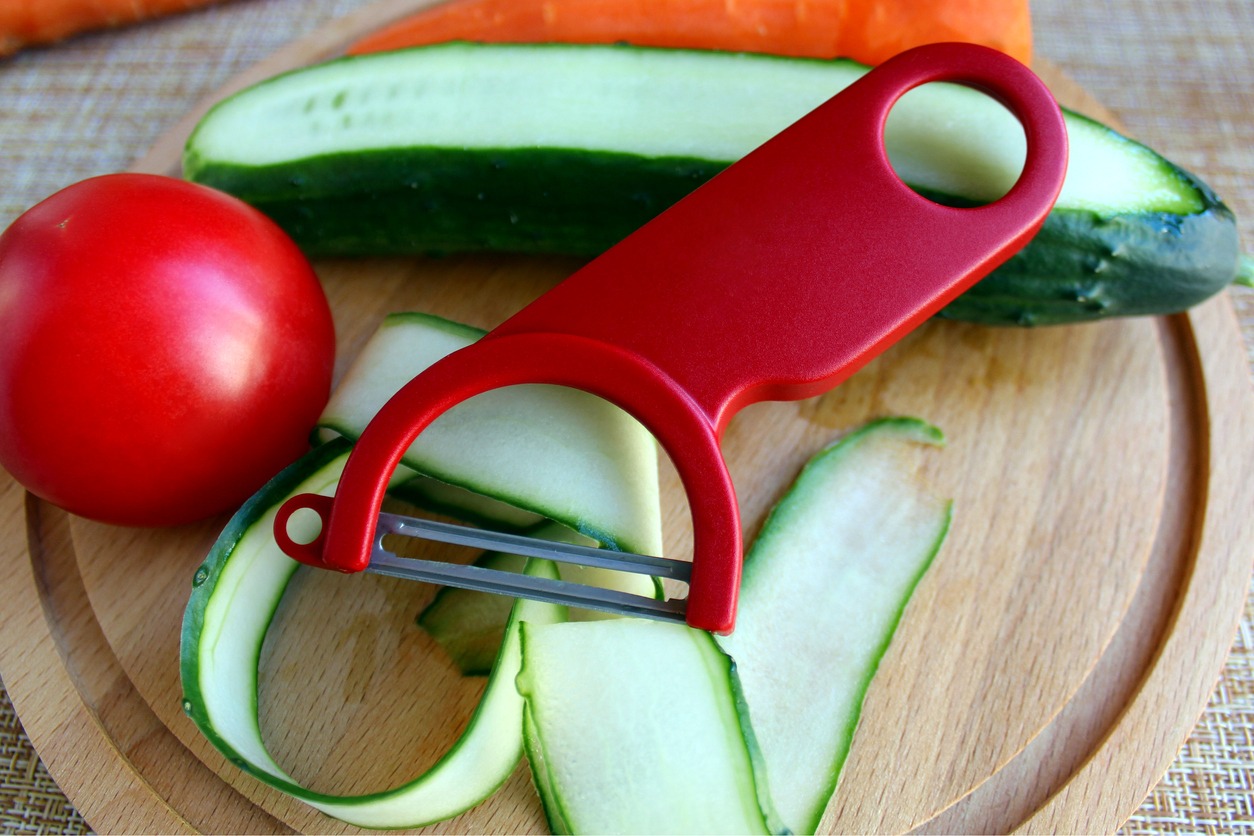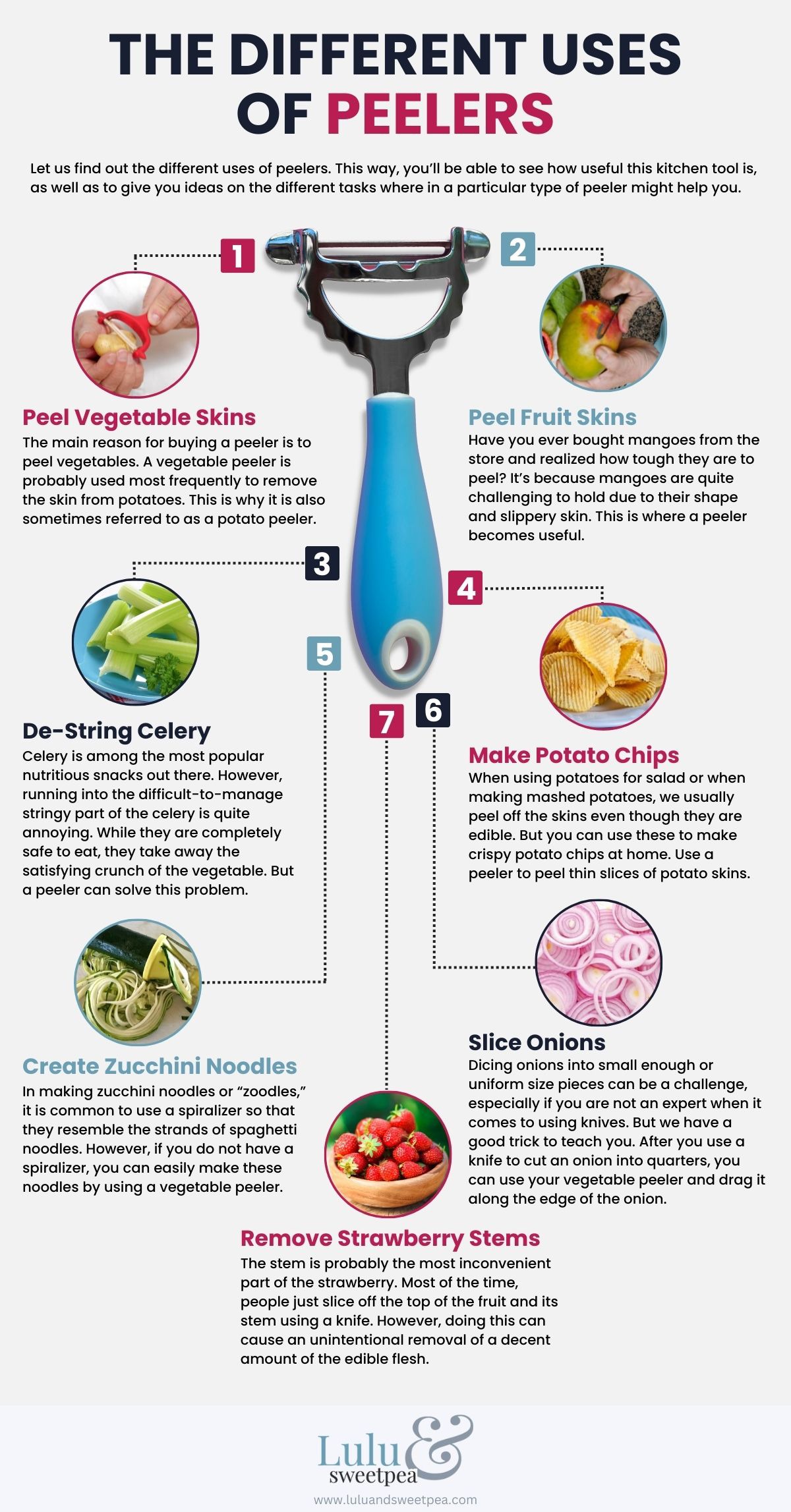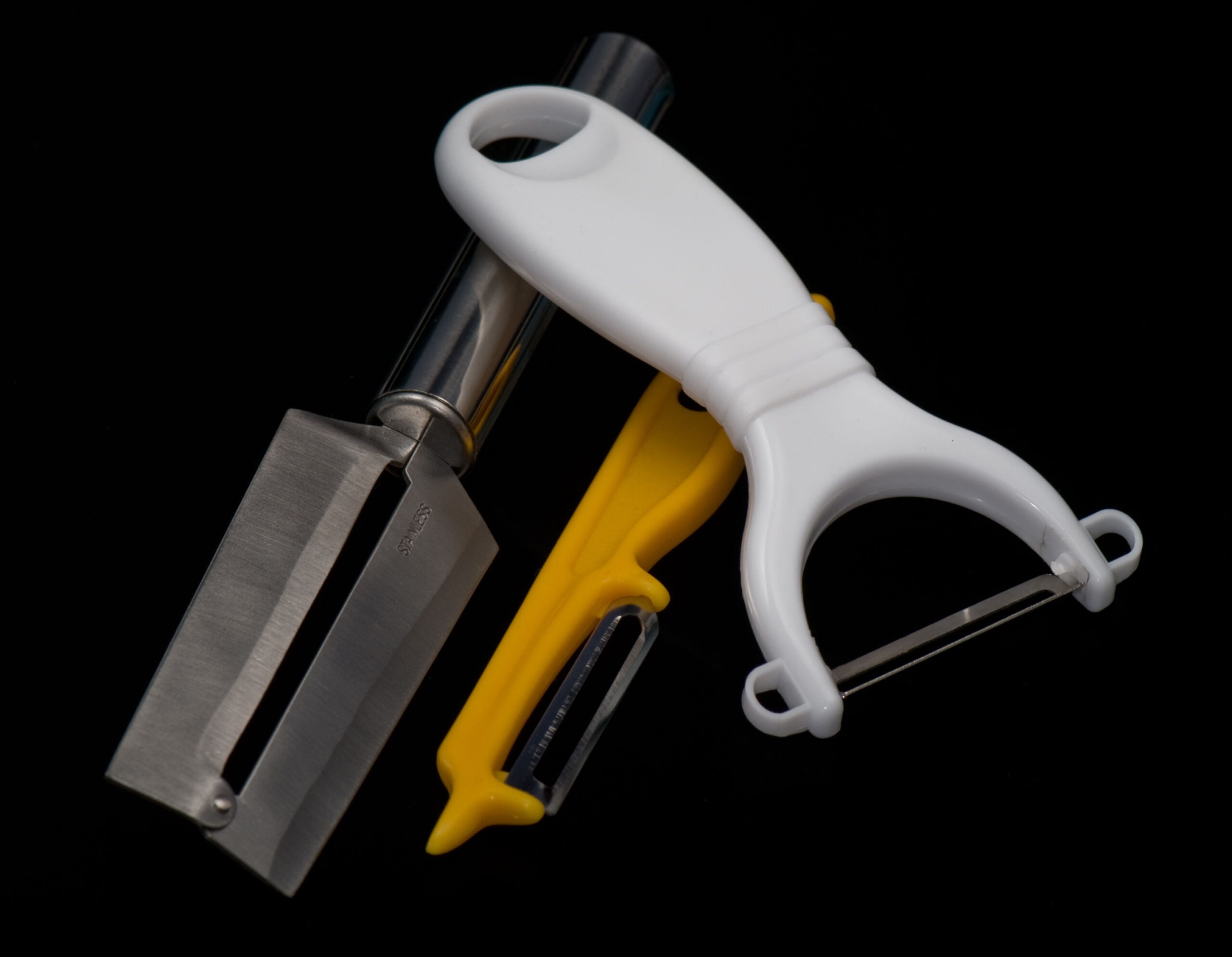The outer layer, commonly referred to as the “skin” or “peel,” of several vegetables and fruits, such as potatoes, broccoli stems, and carrots, is removed with a peeler (also known as a vegetable scraper), a kitchen instrument that has a metal blade with a slot and a sharp edge linked to a handle. A paring knife may also be used to peel vegetables. One sharpened side of a slot in a peeler’s blade prevents the blade from cutting too deeply into the vegetable. Peelers come in a variety of modern styles. Most portable peelers are straight or Y-type, however regional and individual preferences might affect specific designs.
Let us explore this article more about this versatile tool in the kitchen – vegetable peelers and their other uses.
Creative Uses for a Vegetable Peeler
In addition to peeling or removing the skin of fruits and vegetables, below are some of the other creative uses for a vegetable peeler that you might want to try:
Making potato chips
Although potato skins can be eaten, we often peel them to prepare meals like potato salad or mashed potatoes. If you have ever peeled potatoes for these recipes, you’ve undoubtedly thrown out a sizable amount of leftover potato skins. Make sure to keep those delicious potato skins because we have a great recipe for you, whether you care about reducing food waste or you just want to try something new.
Although you need actual potatoes to produce traditional potato chips, you can still make crispy, delectable chips with potato skins! It is recommended to rub the peels in olive oil, sprinkle them with sea salt, and bake them in a single layer at 425 F for around 20 minutes to produce crisp potato skin chips. Feel free to add some of your favorite seasonings to this recipe because it is so easy and can be customized however you desire. Vegetable peelers are very useful when preparing snacks.
Slicing onions
Do we cry while chopping onions because of their enzymes and acids, or is it because it is so difficult to do it right? In actuality, it is a mix of the two. Even while dicing or slicing onions is not particularly difficult, it might be difficult to make the pieces uniformly tiny or thin enough, especially if you are not a skilled knife user.
To achieve excellent, thin, crisp onion slices, you do not need to be an expert knife user. Take your vegetable peeler and run it down the edge of the onion after cutting the onion into quarters and removing the root ends with a knife. You ought to have equally sized, ultra-thin slices after this. For dishes where chopped or diced onions would be too big, this technique is appropriate. Use these thin slices in dishes like pizza or salads so that the onion flavor is not overbearing but rather delicate.
Make fancy salads
There is no shortage of cutting-edge equipment available today that enables us to slice, dice, peel, and chop any vegetable into almost any form. Due to the discovery that chopping vegetables into various shapes and sizes truly impacts how they taste and work in meals, people have grown quite creative in the kitchen and have created new recipes.
For elegant, elevated meals, you do not need to buy any pricey kitchen appliances. Get ready to prepare some amazing, nutritious meals by gathering your go-to vegetable peeler and some ripe vegetables from your yard. Long, thin ribbons that are somewhat crispy and just enjoyable to eat result from using a vegetable peeler to shred longer veggies like carrots, zucchini, squash, or cucumber. For instance, Tasty offers a recipe for a summer salad that asks for drizzling fresh homemade pesto over carrot, squash, and zucchini ribbons.
Make drink garnishes
A cocktail shaker, a muddler, and a bar spoon usually come to mind when you think of a bartender’s toolbox. A vegetable peeler may also be regarded as one of the essential instruments by bartenders or their fellow mixologists. If you have not had an Old Fashioned or a lemon drop martini, you might not be aware that these drinks frequently contain fruit peel. If you have any idea what we are talking about, you may have observed your bartender giving the fruit peel a nice twist above your drink or momentarily lighting the peel on fire before putting it in your drink.
Numerous fragrant oils found in citrus fruit peels can enhance a beverage’s flavor in ways that the fruit’s flesh cannot. To improve specific cocktails, bartenders use a part of the fruit’s skin that they gently remove using a vegetable peeler. They even choose their peelers carefully based on the sort of fruit they are peeling (via Wine Enthusiast). Lemons, oranges, limes, and grapefruits are some of the citrus fruits that are frequently used for these reasons. A twisted orange or lemon peel not only adds flavor but also makes a stylish garnish for any beverage.
Make cheese shavings
There are countless ways to enjoy cheese. If there is a possibility to include cheese in a meal, we will find a way to do it, and we will adore it every time. This includes crumbling it over salads, melting it over soups, and sprinkling it over pasta. Making cheese shavings to put in a dish is a great way to enjoy some cheeses that are generally hard and not particularly crumbly.
It is worth experimenting with a vegetable peeler to achieve long, thin strips rather than the little, delicate bits that hard and aged cheeses like pecorino or Manchego are typically grated into with a cheese grater. These very thin cheese peels add flavor to recipes and melt rather rapidly. Using cheese in its peel form as opposed to grated form allows you to enjoy the flavor more fully. Try shaving some fresh parmesan instead of using a grater the next time you are assembling a salad; we guarantee you will like the difference.
Make chocolate shavings
We adore chocolate, regardless of its size, shape, or composition. We are constantly looking for fresh dessert ideas and inventive ways to incorporate chocolate. Making chocolate shavings or curls with a vegetable peeler is a distinctive approach to generating artistic, refined treats.
Whether you prefer milk chocolate, dark chocolate, or white chocolate, you can produce chocolate shavings or curls from a variety of chocolate varieties. Simply run the vegetable peeler blade down the chocolate bar to experiment with different sizes and shapes by peeling the chocolate bar’s various sides. To prevent the chocolate from becoming too firm or too soft, remember to do this when it is at room temperature. Any dessert may become more upscale by adding chocolate shavings. They may be used to garnish your favorite chocolate cake or to shave on top of a luscious chocolate pavlova.
Make vegetable ribbons
Create beautiful ribbons out of your veggies to use in salads, sandwiches, and more.
Shaving butter
All of us have been there. You want to whip up some fast cookies or have a delicious slice of toast in mind, but when you pull a stick of butter out of the fridge, it is solid as a rock. Throwing the butter stick into the microwave for a few seconds is a typical remedy to this problem, but occasionally doing so might result in the butter melting too much and endanger your dish or the entire stick of butter. Or perhaps you are having trouble cutting into a stick of butter that you froze for a dish using pastry.
Whatever the circumstance, a too-hard stick of butter may be broken with the use of one straightforward appliance: a vegetable peeler. Approaching the butter in a different method can prevent you from breaking your bread and spreading the butter unevenly when attempting to smush a hard piece of butter into your bread. Watch the butter melt rapidly and uniformly as you hold the butter stick and delicately peel a few little curls of butter onto your toast.
Making zucchini noodles
You might be familiar with zucchini noodles, sometimes known as “zoodles,” given their rapid rise in popularity over the past few years. They gained popularity as a low-carb or gluten-free substitute for spaghetti noodles made from wheat, but they are also a simple, interesting, and delectable method to increase your intake of veggies.
For zucchini noodles that more nearly resemble long, cylindrical strands of spaghetti, a spiralizer is frequently used. If you don’t have a spiralizer, a vegetable peeler may be used to construct a spaghetti dish using zucchini as the main ingredient. You may make zucchini pasta that is more akin to fettuccini or pappardelle by shaving flat ribbons of zucchini with a peeler. According to the zucchini pasta recipe from The New York Times, zucchini should be peeled into long ribbons, the seeded core removed, and the noodles cooked for a few minutes in a pot with tomato sauce, extra virgin olive oil, and kosher salt.
Removing strawberry stems
We are all aware that the strawberry’s stem is the most bothersome part. By default, the majority of people often just use a knife to cut the strawberry’s top and stem off. While this approach resolves the stem-removal problem, it frequently unintentionally removes a sizable portion of the edible strawberry flesh. In addition, removing the strawberry’s top distorts the berry’s form and detracts from its aesthetic attractiveness.
We have a clever way to remove strawberry stems quickly and effectively without sacrificing the fruit’s visual appeal. According to Fine Cooking, you may entirely remove those bothersome stems by using the vegetable peeler’s pointed edge. The peeler’s pointed end is generally used to scrape undesirable patches off of potatoes, but if you carefully tuck its tip under the strawberry stem and twist, it should easily come out!
De-stringing celery
Celery is a well-known low-calorie snack that is popular among those who are trying to reduce weight or just want to eat healthier. Celery naturally includes a ton of antioxidants, anti-inflammatory compounds, vitamins, and minerals that are good for general health.
You have probably encountered that unpleasant, challenging stringy section of the plant, whether you have tried eating celery whole or slicing it up for recipes. Thrive Cuisine claims that those annoying stringy parts might result from a celery stalk that grew under less-than-ideal circumstances. Although they are entirely edible and are merely a component of the plant, they might lessen the delightful crunch of a mouthful of celery. Grab a veggie peeler, and wave goodbye to your celery string phobias. According to Thrive Cuisine, removing the outer covering of a celery stalk with a peeler will eliminate the stringy threads and leave you with a crisp stick of celery.
Seed a chili
Holding a firm chili by the stem, pull the skin away from the body. Use the peeler’s tip to carefully scrape off the seeds. For seeds that will not budge, use a tiny knife. Use cold water to rinse the pepper. Now that the seeds are gone, you can cook. When handling chili, use caution and always wash your hands.
Decorating a lemon
It is easy to garnish a lemon using a vegetable peeler. Peeling the skin off the lemon in fine strips requires the use of both hands. The strips can be twisted into spirals or curled around objects. Use as a garnish on foods or beverages. Give your display some color and flavor with a pop.
Zesting citrus fruits
To add citrus flavors to your beverages, you do not need a rasp. To prepare a long string of citrus fruit for a nighttime drink, use a peeler.
Carving decorative soaps
The answer is that you can use a vegetable peeler outside of the kitchen. Although we refer to them as vegetable or potato peelers, these implements are just sharpened blades that are simple to grip and use. As a result, you potentially could carve many different objects with them or even sharpen pencils.
For beveling soap bars’ edges so they have smooth, presentable edges, artisan soap makers frequently use vegetable peelers. The artistic soaps seem more polished and enticing as a result. To prevent uneven peels during beveling, attempt to maintain a constant amount of pressure while peeling. Vegetable peelers are another tool used by those who work in the soap art industry to etch designs into soap bars. Can you get famous with a vegetable peeler? If you decide to set up a camera, you might want to acquire a vegetable peeler and a bar of soap to record one of those popular ASMR movies of people peeling soap.
If you want to learn more about the different uses of peelers, check out this graphic for more guidance:
Tips and Techniques for Using a Vegetable Peeler
Below are some tips and techniques for using a vegetable peeler safely and more effectively:
Choose the right type of peeler for the job
Which vegetable peeler is the best? It varies; a Lancashire peeler is a fine all-purpose tool, though it can be challenging to use for extended periods. A serrated peeler is your best bet for soft vegetables. For long, thin produce, use swivel peelers, and for huge, spherical food, try y-peelers. Using a julienne peeler to cut long strips for zoodles or salads is recommended. Try a mechanical peeler for an ergonomic rapid peeler.
Hold the peeler correctly
To peel safely and effectively, it’s important to hold the vegetable peeler properly. To hold the peeler properly, grasp the handle firmly with your dominant hand and provide support with your index finger on top of the handle. For control, place your thumb on the handle’s underside. While peeling, place your other hand on the vegetable and hold it steadily. To prevent unintentionally cutting yourself, keep your fingers curled away from the blade. Before beginning to peel, practice holding the peeler and the vegetable, and make any necessary grip adjustments to find the position that works best for you. Peeling will be safer and easier if you have a comfortable and solid grasp.
Hold the vegetable securely
For safe and effective vegetable peeling, the produce must be held firmly in place. While using the peeler, one hand should grasp the vegetable firmly in the other. To offer a firm platform for bigger veggies, such as potatoes, set them on a chopping board. Use your non-dominant hand to hold the veggie while keeping your fingers safely tucked away. When handling smaller veggies, keep your fingers curled away from the blade and hold them in your non-dominant hand. Holding the vegetable firmly is essential to avoid it sliding or moving during peeling, which might lead to mishaps or uneven peeling.
Angle the peeler
The blade of a vegetable peeler needs to be angled properly to be used successfully. The blade of the peeler should be facing away from you while you hold it at a small angle to the vegetable. With the blade at this angle, the skin may be removed without damaging the vegetable’s flesh too much. Keep the blade as parallel to the veggie as you can for the greatest results. You may remove the skin in neat, thin strips by doing this. To guarantee a uniform peel and lessen the chance of cutting oneself accidentally, it is crucial to keep the same angle throughout the peeling process.
Apply gentle pressure
It is important to use a vegetable peeler with little pressure on the blade. If you press down too hard, the blade can slide and sever your hand or dig into the vegetable. Use a little touch instead and let the blade’s edge do the work. Applying greater pressure to skin that is harder and less pressure to skin that is softer depends on the thickness and texture of the skin. You may remove the skin smoothly and safely by using the proper pressure.
Use a smooth surface
When peeling vegetables, it is important to have a flat surface so that the blade may go easily over the vegetable skin. A level, solid surface for peeling might be found on a cutting board or a spotless countertop. As a result, the vegetable will not slip, and the peeling process will be more carefully managed. The use of uneven or slippery surfaces, such as plates or bowls, can make peeling challenging and increase the risk of injury. Vegetable peeling will be simpler and more effective if you use a smooth surface to assist you to obtain a more equal peel.
Maintain the blade of your vegetable peeler
For secure and efficient peeling, you must keep your vegetable peeler’s blade sharp. Peeling may be more dangerous and difficult with a dull blade. Regularly sharpen the blade with a honing steel or a sharpening stone to maintain it. Replace the peeler if the blade is broken or is too dull to be sharpened. The peeler should be kept dry and clean when not in use to avoid rusting. Additionally, keep in mind that using the peeler on things like ceramic plates that are hard might harm the blade. Your vegetable peeler will last longer and operate at its peak performance if the blade is kept clean and properly maintained.
Practice makes perfect
Vegetable peeling with a peeler requires practice, just like any other talent. Maintain your efforts, and you will quickly master it!
Conclusion
In conclusion, this vegetable peeler is a flexible and all-around tool for your kitchen. This is a must-have for your kitchen used from making thin slices of fruits and vegetables to garnishing. Follow the tips and techniques to avoid accidents and make peeling safer. Do not hesitate to try this tool when you prepare different kinds of dishes in your kitchen. Enjoy!




